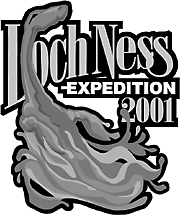If summer days at the lake suggest simple pleasures, Robert H. Rines' summer plans for the lake, Loch Ness that is, could not be more dissimilar. Long a believer in the existence of Nessie, Academy President Rines, along with a world-renowned team of experts, will spend the summer scouring Loch Ness in the most ambitious and far-reaching effort to uncover hard evidence of Nessie. "We have never before had enough time to uncover everything," says Rines. "Is there anything still there?" he questions. "That's the hope."
 The team will operate from a new permanent station named after the late Charles W. Wycoff, an Academy board member and noted photographic and scientist member of prior expeditions. They have assembled state-of-the-art equipment including the latest generation of side-scan sonar and remotely operated vehicles as well as low-level remotely controlled video cameras. "Such an array of modern equipment has never been assembled at the loch before," says Rines.
The team will operate from a new permanent station named after the late Charles W. Wycoff, an Academy board member and noted photographic and scientist member of prior expeditions. They have assembled state-of-the-art equipment including the latest generation of side-scan sonar and remotely operated vehicles as well as low-level remotely controlled video cameras. "Such an array of modern equipment has never been assembled at the loch before," says Rines.
This advanced technology is essential, considering that this peat-stained, murky, long-arm-of-the-sea freshwater loch is over 800 feet deep, a mile wide, and 24 miles long. The sophisticated equipment will enable the team in its search for the both a living "monster" (known also by its Latin name, Nessiteras Rhombopteryx) and for skeletal carcasses and bones.
Hampered in the past by balky equipment, hopes run high for this new technology. The side-scan sonar, which is towed from the end of the boat, produces an "acoustic net" with a beam which transversely floods the loch with sound transmissions from its depths to its surface as the boat travels up and down the lake.
However, Rines is quick to point out that "the hardware is only part of the equation. The experts who will be operating the equipment are among the most experienced in the world at what they do. Also, almost everyone on this year's expedition has been with us before so this won't be a disparate group of individuals but a real team of dedicated people coming together again to solve an age-old mystery."
Loch Ness, the most famous of the 265 worldwide lakes with monster sightings, has been the center of controversy for decades. Dozens of compelling eyewitness accounts, including Rines' own riveting 1972 observation with his late wife Carol and others, offer a tantalizing account of the possibility. Many of the photos taken, though blurry and indistinct, support the possible existence of the "monster." Perhaps the most famous photo is Rines' own "body, neck, and head" picture which was taken during the Academy's 1975 expedition and reprinted on the pages of the prestigious Nature and MIT Technology Review magazines.
Hoping to glean additional insight into the loch, several scientific projects will be conducted under the Academy's banner. Scottish geologists and archeologists will examine underwater findings bearing upon the formation of the Great Glen from the last Ice Age, as well as studying an ancient fortified island and manmade artifacts. Reporting on the exploration will be the Learning Channel and 60 Minutes II. Log on to aas-world.org and to www. concordmonitor.com for details of the expedition through mid-August.
The TEAM
Just who will be spending a good part of their summer searching the world famous lake in northern Scotland for what may be a plesiosaur descendent of the "extinct" aquatic elasmasauros dinosaur family?
Bob Rines, Academy President
Bill Charbonneau from Benthos
Co., a Massachusetts underwater
electronics equipment company
John Perry Fish, Arnie Carr,
and Jim Archer from American Underwater Search and Survey (U.S. sonar experts, they were called in by the Navy for help in recovering debris from the crash of TWA 800.)
Chris and Mike Nicholson of Deep Sea Systems, manufacturer of the remotely operated underwater vehicle, who will operate the vehicle.
Emory Kristof, renowned National Geographic explorer and
photographer
Gordon Menzies, Scottish sonar and fisheries expert and boat manager
Duane Marshall, electronics expert of prior expeditions
Sheldon Apsell, inventor and CEO of Micrologics
Ike Blonder, inventor and founder of Blonder Tongue Laboratories
Ralph Rodriquez, Vice President of C-Bridge, an electronics company
Joanne Hayes-Rines, Publisher, Inventors' Digest magazine
Justice C. Rines, research
coordinator
Lisa Rines Toth, Elijah Eroclino and Bill Zimmerman, P.R. coordinators
Gordon Jackson and Carolyn Choate, Channel 13, Nashua, N.H.
Alison Wilkie and Frank Dougherty, Albavision, Inverness
Harry Moses, CBS, 60 Minutes II
Richard Smith, journalist
Peter Bryne, explorer